MaryAnn Bernal's Blog, page 257
July 19, 2014
History Trivia - Battle of Halidon Hill – The English defeat the Scots
July 19

711 Umayyad conquest of Hispania: Battle of Guadalete – Muslim Umayyad Caliphate forces under Tariq ibn Ziyad defeated the Visigoths led by King Roderic.

1318 Austria recognized the Three Forest Cantons, marking the beginning of modern Switzerland.
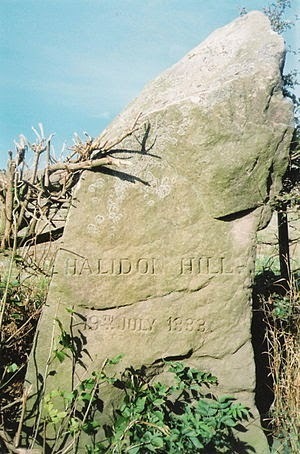
1333 Wars of Scottish Independence: Battle of Halidon Hill – The English won a decisive victory over the Scots.

1545 The Tudor warship Mary Rose capsized and sank off Portsmouth with the loss of approximately 500 men.

1553 Lady Jane Grey was replaced by Mary I of England as Queen of England after only nine days of reign.

1588 Anglo-Spanish War: Battle of Gravelines – The Spanish Armada was sighted in the English Channel.


711 Umayyad conquest of Hispania: Battle of Guadalete – Muslim Umayyad Caliphate forces under Tariq ibn Ziyad defeated the Visigoths led by King Roderic.

1318 Austria recognized the Three Forest Cantons, marking the beginning of modern Switzerland.

1333 Wars of Scottish Independence: Battle of Halidon Hill – The English won a decisive victory over the Scots.

1545 The Tudor warship Mary Rose capsized and sank off Portsmouth with the loss of approximately 500 men.

1553 Lady Jane Grey was replaced by Mary I of England as Queen of England after only nine days of reign.

1588 Anglo-Spanish War: Battle of Gravelines – The Spanish Armada was sighted in the English Channel.

Published on July 19, 2014 05:35
July 18, 2014
History Trivia - Great fire of Rome while Emperor Nero allegedly fiddles
July 18

390 BC Roman-Gaulish Wars: Battle of the Allia – a Roman army was defeated by raiding Gauls, leading to the subsequent sacking of Rome.

64 Great fire of Rome: a fire started in the merchant area of Rome near Circus Maximus and much of the city was destroyed while Emperor Nero allegedly fiddled.

1290 King Edward I of England issued the Edict of Expulsion, banishing all Jews (numbering about 16,000) from England.

1334 The bishop of Florence blessed the first foundation stone for the new campanile (bell tower) of the Florence Cathedral, designed by the artist Giotto di Bondone.

1389 Kingdom of France and Kingdom of England agreed to the Truce of Leulinghem, inaugurating a 13 year peace; the longest period of sustained peace during the Hundred Years War.


390 BC Roman-Gaulish Wars: Battle of the Allia – a Roman army was defeated by raiding Gauls, leading to the subsequent sacking of Rome.

64 Great fire of Rome: a fire started in the merchant area of Rome near Circus Maximus and much of the city was destroyed while Emperor Nero allegedly fiddled.

1290 King Edward I of England issued the Edict of Expulsion, banishing all Jews (numbering about 16,000) from England.

1334 The bishop of Florence blessed the first foundation stone for the new campanile (bell tower) of the Florence Cathedral, designed by the artist Giotto di Bondone.

1389 Kingdom of France and Kingdom of England agreed to the Truce of Leulinghem, inaugurating a 13 year peace; the longest period of sustained peace during the Hundred Years War.

Published on July 18, 2014 03:34
July 17, 2014
History Trivia - The French defeat the English at the Battle of Castillon
July 17
 Edward the Elder
Edward the Elder
 Alfred the Great 924 King Edward the Elder of England died. He became king in 899 upon the death of his father, Alfred the Great. His court was at Winchester, previously the capital of Wessex. He captured the eastern Midlands and East Anglia from the Danes in 917 and became ruler of Mercia in 918 upon the death of Æthelflæd, his sister. He was the second king of the Anglo-Saxons as this title was created by his father.
Alfred the Great 924 King Edward the Elder of England died. He became king in 899 upon the death of his father, Alfred the Great. His court was at Winchester, previously the capital of Wessex. He captured the eastern Midlands and East Anglia from the Danes in 917 and became ruler of Mercia in 918 upon the death of Æthelflæd, his sister. He was the second king of the Anglo-Saxons as this title was created by his father.

1203 The Fourth Crusade captured Constantinople by assault. The Byzantine emperor Alexius III Angelus fled from his capital into exile.
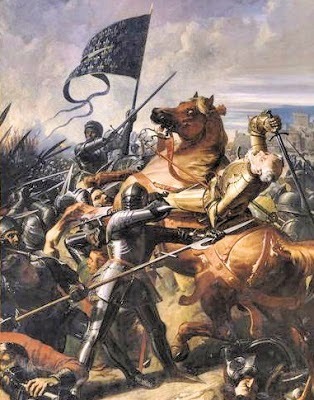
1453 The French defeated the English at the Battle of Castillon, in the last clash of the Hundred Years War.

 Edward the Elder
Edward the Elder
 Alfred the Great 924 King Edward the Elder of England died. He became king in 899 upon the death of his father, Alfred the Great. His court was at Winchester, previously the capital of Wessex. He captured the eastern Midlands and East Anglia from the Danes in 917 and became ruler of Mercia in 918 upon the death of Æthelflæd, his sister. He was the second king of the Anglo-Saxons as this title was created by his father.
Alfred the Great 924 King Edward the Elder of England died. He became king in 899 upon the death of his father, Alfred the Great. His court was at Winchester, previously the capital of Wessex. He captured the eastern Midlands and East Anglia from the Danes in 917 and became ruler of Mercia in 918 upon the death of Æthelflæd, his sister. He was the second king of the Anglo-Saxons as this title was created by his father. 
1203 The Fourth Crusade captured Constantinople by assault. The Byzantine emperor Alexius III Angelus fled from his capital into exile.

1453 The French defeated the English at the Battle of Castillon, in the last clash of the Hundred Years War.

Published on July 17, 2014 04:40
July 16, 2014
Ancient Priest's Tomb Painting Discovered Near Great Pyramid at Giza
By Owen Jarus
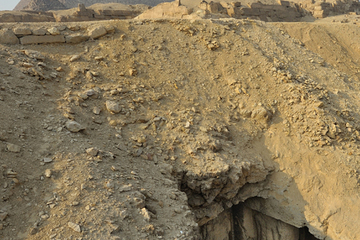
 A painting discovered in the tomb of a priest, just 1,000 feet (300 meters) from the Great Pyramid at Giza in Egypt depicts scenes of ancient life.
A painting discovered in the tomb of a priest, just 1,000 feet (300 meters) from the Great Pyramid at Giza in Egypt depicts scenes of ancient life.
Credit: Photo courtesy Maksim Lebedev
A wall painting, dating back over 4,300 years, has been discovered in a tomb located just east of the Great Pyramid of Giza.
The painting shows vivid scenes of life, including boats sailing south on the Nile River, a bird hunting trip in a marsh and a man named Perseneb who's shown with his wife and dog.
While Giza is famous for its pyramids, the site also contains fields of tombs that sprawl to the east and west of the Great Pyramid. These tombs were created for private individuals who held varying degrees of rank and power during the Old Kingdom (2649-2150 B.C.), the age when the Giza pyramids were built
The new painting was discovered in 2012 by a team from the Institute of Oriental Studies of the Russian Academy of Sciences, which has been excavating these tombs since 1996.
A surprise discovery
Scientists discovered the painting when they began restoring the tomb of Perseneb, a man who was a "priest" and "steward," according to the tomb's inscriptions.
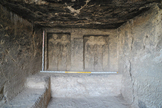
[image error] The ancient tomb, possibly for a priest, contains a central room (shown here), with four statues.
The ancient tomb, possibly for a priest, contains a central room (shown here), with four statues.
Credit: Photo courtesy Maksim Lebedev
View full size imageHis tomb, located 1,000 feet (300 meters) east of the Great Pyramid of Giza, contains an offering room, central room and burial chamber. The three rooms contain 11 statues showing depictions of Perseneb and members of his family. First recorded in the 19th century by the German explorer Karl Richard Lepsius and French Egyptologist Auguste Mariette, the tomb is believed to date to the middle or late fifth dynasty (ca. 2450-2350 B.C.). The fifth dynasty is a time period within the Old Kingdom.
"Known since the 19th century, the [tomb] could hardly present any new principal features. Therefore, it was a real surprise to discover an Old Kingdom painting on the eastern wall of the central room," wrote Maksim Lebedev, a reader (the American equivalent is a professor) at the Russian State University for the Humanities, in an email to Live Science.
"The painting was made on a thin layer of fine white plaster darkened with 19th-century soot and dirt. By the time of recording, only about 30 percent of the original plaster had preserved on the wall," Lebedev said.
Since the 19th century, the growth and industrialization of Cairo has led to problems with pollution at Giza. And the fact that people were actually living inside the tomb in some periods (including the Middle Ages) also damaged the painting, Lebedev said.
Nevertheless, "none of the scenes has been lost completely. The remaining traces allow [for the] reconstruction [of] the whole composition," Lebedev said.
Scenes of life
The reconstructed painting reflects ancient life. At the top of the painting there are images of boats sailing the Nile River, their sails pointing south. They "probably represent the return of the owner from the north after a pilgrimage or inspection of his funerary estates," Lebedev said. Funerary estates were tax-exempt property left by the deceased to help support surviving dependents and the upkeep of his tomb. [Photos: Amazing Discoveries at Egypt's Giza Pyramids]
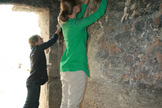
[image error] Archaeologists removed dirt and soot from the tomb painting.
Archaeologists removed dirt and soot from the tomb painting.
Credit: Photo courtesy Maksim Lebedev
View full size imageThe painting's "two lower registers preserved representations of various agricultural scenes: plowing, sowing, workers driving sheep over sown seed, driving donkeys laden with sheaves to the threshing floor," Lebedev said.
The painting also shows an image of Perseneb, his wife and what appears to be his dog. There is also a marsh scene with a man on a boat who appears to be bird hunting.
"All the depicted scenes had important symbolic meanings. Fowling (bird hunting) in the marshland could refer to the ideas of rebirth and taming of chaotic forces," Lebedev said. "The full agricultural sequence relating to crops represents the most crucial event in the life of ancient Egyptian society," he added. Also, the representation of "boats with sails going southwards is another important tomb subject, which reflected the high status of the person."
More discoveries to come
The area the Russian team has been excavating contains a number of tombs that may hold undiscovered wall paintings. The team has found indirect evidence for paintings in some tombs, such as very smooth walls and remains of wall plaster and paint, Lebedev said.
"Since many rock-cut chapels of the eastern edge of the Giza plateau were rapidly excavated or just recorded [without excavation] in the first half of the 20th century, sometimes without sufficient documentation, and still covered with thick layers of rough plaster left from later inhabitants [who lived in the tombs], one may expect that more paintings will be discovered in this part of the necropolis."
The tomb of Perseneb was partly restored by the Russian mission in 2013. The work was supported by a donation from the Thames Valley Ancient Egyptian Society in the United Kingdom.
The painting reconstructions will be published, in full, in a scholarly publication in the future. The images on Live Science show just a few of the reconstructed scenes.
http://www.livescience.com/46806-tomb-painting-discovered-near-great-pyramid.html


 A painting discovered in the tomb of a priest, just 1,000 feet (300 meters) from the Great Pyramid at Giza in Egypt depicts scenes of ancient life.
A painting discovered in the tomb of a priest, just 1,000 feet (300 meters) from the Great Pyramid at Giza in Egypt depicts scenes of ancient life. Credit: Photo courtesy Maksim Lebedev
A wall painting, dating back over 4,300 years, has been discovered in a tomb located just east of the Great Pyramid of Giza.
The painting shows vivid scenes of life, including boats sailing south on the Nile River, a bird hunting trip in a marsh and a man named Perseneb who's shown with his wife and dog.
While Giza is famous for its pyramids, the site also contains fields of tombs that sprawl to the east and west of the Great Pyramid. These tombs were created for private individuals who held varying degrees of rank and power during the Old Kingdom (2649-2150 B.C.), the age when the Giza pyramids were built
The new painting was discovered in 2012 by a team from the Institute of Oriental Studies of the Russian Academy of Sciences, which has been excavating these tombs since 1996.
A surprise discovery
Scientists discovered the painting when they began restoring the tomb of Perseneb, a man who was a "priest" and "steward," according to the tomb's inscriptions.

[image error]
 The ancient tomb, possibly for a priest, contains a central room (shown here), with four statues.
The ancient tomb, possibly for a priest, contains a central room (shown here), with four statues.Credit: Photo courtesy Maksim Lebedev
View full size imageHis tomb, located 1,000 feet (300 meters) east of the Great Pyramid of Giza, contains an offering room, central room and burial chamber. The three rooms contain 11 statues showing depictions of Perseneb and members of his family. First recorded in the 19th century by the German explorer Karl Richard Lepsius and French Egyptologist Auguste Mariette, the tomb is believed to date to the middle or late fifth dynasty (ca. 2450-2350 B.C.). The fifth dynasty is a time period within the Old Kingdom.
"Known since the 19th century, the [tomb] could hardly present any new principal features. Therefore, it was a real surprise to discover an Old Kingdom painting on the eastern wall of the central room," wrote Maksim Lebedev, a reader (the American equivalent is a professor) at the Russian State University for the Humanities, in an email to Live Science.
"The painting was made on a thin layer of fine white plaster darkened with 19th-century soot and dirt. By the time of recording, only about 30 percent of the original plaster had preserved on the wall," Lebedev said.
Since the 19th century, the growth and industrialization of Cairo has led to problems with pollution at Giza. And the fact that people were actually living inside the tomb in some periods (including the Middle Ages) also damaged the painting, Lebedev said.
Nevertheless, "none of the scenes has been lost completely. The remaining traces allow [for the] reconstruction [of] the whole composition," Lebedev said.
Scenes of life
The reconstructed painting reflects ancient life. At the top of the painting there are images of boats sailing the Nile River, their sails pointing south. They "probably represent the return of the owner from the north after a pilgrimage or inspection of his funerary estates," Lebedev said. Funerary estates were tax-exempt property left by the deceased to help support surviving dependents and the upkeep of his tomb. [Photos: Amazing Discoveries at Egypt's Giza Pyramids]

[image error]
 Archaeologists removed dirt and soot from the tomb painting.
Archaeologists removed dirt and soot from the tomb painting.Credit: Photo courtesy Maksim Lebedev
View full size imageThe painting's "two lower registers preserved representations of various agricultural scenes: plowing, sowing, workers driving sheep over sown seed, driving donkeys laden with sheaves to the threshing floor," Lebedev said.
The painting also shows an image of Perseneb, his wife and what appears to be his dog. There is also a marsh scene with a man on a boat who appears to be bird hunting.
"All the depicted scenes had important symbolic meanings. Fowling (bird hunting) in the marshland could refer to the ideas of rebirth and taming of chaotic forces," Lebedev said. "The full agricultural sequence relating to crops represents the most crucial event in the life of ancient Egyptian society," he added. Also, the representation of "boats with sails going southwards is another important tomb subject, which reflected the high status of the person."
More discoveries to come
The area the Russian team has been excavating contains a number of tombs that may hold undiscovered wall paintings. The team has found indirect evidence for paintings in some tombs, such as very smooth walls and remains of wall plaster and paint, Lebedev said.
"Since many rock-cut chapels of the eastern edge of the Giza plateau were rapidly excavated or just recorded [without excavation] in the first half of the 20th century, sometimes without sufficient documentation, and still covered with thick layers of rough plaster left from later inhabitants [who lived in the tombs], one may expect that more paintings will be discovered in this part of the necropolis."
The tomb of Perseneb was partly restored by the Russian mission in 2013. The work was supported by a donation from the Thames Valley Ancient Egyptian Society in the United Kingdom.
The painting reconstructions will be published, in full, in a scholarly publication in the future. The images on Live Science show just a few of the reconstructed scenes.
http://www.livescience.com/46806-tomb-painting-discovered-near-great-pyramid.html

Published on July 16, 2014 08:02
History Trivia - 1439 - Kissing banned in England to stop germs from spreading.
July 16,

276 Mark Annius Florianus, emperor of Rome, was murdered.
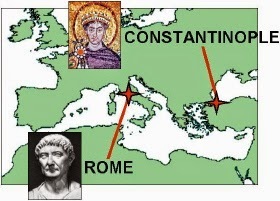
1054 Three Roman legates broke relations between Western and Eastern Christian Churches through the act of placing an invalidly-issued Papal Bull of Excommunication on the altar of Hagia Sophia during Saturday afternoon divine liturgy. Historians frequently describe the event as the start of the East-West Schism.
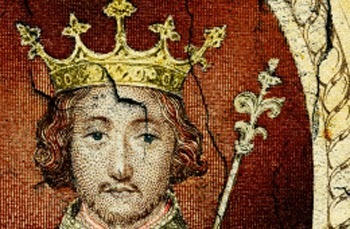
1377 Coronation of Richard II of England. Richard was a son of Edward, the Black Prince and was born during the reign of his grandfather, Edward III.

1429 Joan of Arc led the French army in Battle of Orleans.

1439 Kissing was banned in England to stop germs from spreading.


276 Mark Annius Florianus, emperor of Rome, was murdered.

1054 Three Roman legates broke relations between Western and Eastern Christian Churches through the act of placing an invalidly-issued Papal Bull of Excommunication on the altar of Hagia Sophia during Saturday afternoon divine liturgy. Historians frequently describe the event as the start of the East-West Schism.

1377 Coronation of Richard II of England. Richard was a son of Edward, the Black Prince and was born during the reign of his grandfather, Edward III.

1429 Joan of Arc led the French army in Battle of Orleans.

1439 Kissing was banned in England to stop germs from spreading.

Published on July 16, 2014 04:32
July 15, 2014
Stolen 'Nest of Dinosaurs' Returned to Mongolia
By Megan Gannon
[image error] Nearly 100 years ago, Mongolia made it illegal to own or export objects of cultural importance, such as dinosaur fossils. These bones were among a hoard of illegally obtained dinosaur skeletons seized by U.S. authorities.
Nearly 100 years ago, Mongolia made it illegal to own or export objects of cultural importance, such as dinosaur fossils. These bones were among a hoard of illegally obtained dinosaur skeletons seized by U.S. authorities.
Credit: HSI
More than 18 dinosaur skeletons illegally taken from Mongolia were formally returned to their homeland last week, U.S. authorities announced.
The fossilized bones were handed over to Mongolian officials in a repatriation ceremony held July 10 in New York. "Today, we return a veritable nest of dinosaurs," Manhattan U.S. Attorney Preet Bharara said in a statement after the ceremony.
"This is a historic event for the U.S. Attorney's Office, in addition to being a prehistoric event, and we are proud to participate in the return of these dinosaur skeletons to their rightful home," Bharara said
The road to repatriation began two years ago, in 2012, when an auction house in New York was offering a skeleton of a Tarbosaurus bataar — an Asian cousin of Tyrannosaurus rex. Mongolian authorities voiced concern that the specimen had likely been smuggled into the United States. The 70-million-year-old dinosaur species was native to the Gobi desert in Asia, and to date, has only been found in modern-day Mongolia.
The Tarbosaurus sale attracted a bid of more than $1 million, but the suspicions of the Mongolian authorities sparked a long legal battle and federal investigation. U.S. authorities froze the sale, and after a lengthy custody battle, the specimen was returned to Mongolia in May 2013.
Eric Prokopi, a self-described commercial paleontologist who imported the dinosaur, pleaded guilty to criminal charges that he smuggled the skeleton and other fossils into the United States. In June, Prokopi was sentenced to three months in federal prison.
The other Mongolian fossils forfeited by Prokopi during the case were returned in the July 10 ceremony, including a second Tarbosaurus, oviraptors and skeletons of the duckbilled, plant-eating Saurolophus angustirostris.
Federal authorities also returned fossils that had been forfeited by Christopher Moore, a onetime business partner of Prokopi in the United Kingdom, including a third Tarbosaurus, skeletons of a roosterlike Gallimimus dinosaur and a nest of fossilized eggs, all looted from Mongolia.
"The fossils returned today do not belong in the hands of any private collection or one owner," James T. Hayes Jr., special agent in charge of Homeland Security Investigations (HSI) in New York, said in a statement. "They belong to the people of Mongolia where they will be displayed in their national museum alongside the Bataar ICE repatriated last year. HSI will not allow the illicit greed of some to trump the cultural history of an entire nation."
The Mongolian government made it illegal in 1924 to own or export items of cultural significance, including dinosaur fossils.
http://www.livescience.com/46792-stolen-dinosaurs-returned-to-mongolia.html

[image error]
 Nearly 100 years ago, Mongolia made it illegal to own or export objects of cultural importance, such as dinosaur fossils. These bones were among a hoard of illegally obtained dinosaur skeletons seized by U.S. authorities.
Nearly 100 years ago, Mongolia made it illegal to own or export objects of cultural importance, such as dinosaur fossils. These bones were among a hoard of illegally obtained dinosaur skeletons seized by U.S. authorities.Credit: HSI
More than 18 dinosaur skeletons illegally taken from Mongolia were formally returned to their homeland last week, U.S. authorities announced.
The fossilized bones were handed over to Mongolian officials in a repatriation ceremony held July 10 in New York. "Today, we return a veritable nest of dinosaurs," Manhattan U.S. Attorney Preet Bharara said in a statement after the ceremony.
"This is a historic event for the U.S. Attorney's Office, in addition to being a prehistoric event, and we are proud to participate in the return of these dinosaur skeletons to their rightful home," Bharara said
The road to repatriation began two years ago, in 2012, when an auction house in New York was offering a skeleton of a Tarbosaurus bataar — an Asian cousin of Tyrannosaurus rex. Mongolian authorities voiced concern that the specimen had likely been smuggled into the United States. The 70-million-year-old dinosaur species was native to the Gobi desert in Asia, and to date, has only been found in modern-day Mongolia.
The Tarbosaurus sale attracted a bid of more than $1 million, but the suspicions of the Mongolian authorities sparked a long legal battle and federal investigation. U.S. authorities froze the sale, and after a lengthy custody battle, the specimen was returned to Mongolia in May 2013.
Eric Prokopi, a self-described commercial paleontologist who imported the dinosaur, pleaded guilty to criminal charges that he smuggled the skeleton and other fossils into the United States. In June, Prokopi was sentenced to three months in federal prison.
The other Mongolian fossils forfeited by Prokopi during the case were returned in the July 10 ceremony, including a second Tarbosaurus, oviraptors and skeletons of the duckbilled, plant-eating Saurolophus angustirostris.
Federal authorities also returned fossils that had been forfeited by Christopher Moore, a onetime business partner of Prokopi in the United Kingdom, including a third Tarbosaurus, skeletons of a roosterlike Gallimimus dinosaur and a nest of fossilized eggs, all looted from Mongolia.
"The fossils returned today do not belong in the hands of any private collection or one owner," James T. Hayes Jr., special agent in charge of Homeland Security Investigations (HSI) in New York, said in a statement. "They belong to the people of Mongolia where they will be displayed in their national museum alongside the Bataar ICE repatriated last year. HSI will not allow the illicit greed of some to trump the cultural history of an entire nation."
The Mongolian government made it illegal in 1924 to own or export items of cultural significance, including dinosaur fossils.
http://www.livescience.com/46792-stolen-dinosaurs-returned-to-mongolia.html

Published on July 15, 2014 11:36
Vintage Bling: Ancient Celts May Have Had Shiny Dental Implants
By Tia Ghose
[image error] Credit: PHOTO FUN/Shutterstock.com
Credit: PHOTO FUN/Shutterstock.com
Sparkly, gold grills aren't just for Flavor Flav; ancient Celts may have sought out flashy smiles as well. Archaeologists have unearthed a dental implant in a grave in France that dates to the third century B.C.
The implant — an iron pin that may have screwed into the gum to hold a decorative tooth in place — was found in the mouth of a skeleton in a Celtic burial site in La Chêne, France. The tooth was described in the June issue of the journal Antiquity. [Smile Secrets: 5 Things Your Grin Reveals About You]
Though it's not clear what the false tooth would have been made of, it was likely put in to enhance the owner's smile, said Guillaume Seguin, an archaeologist at Archeosphere in France and co-author of the study.
"In Le Chêne, the replaced tooth is a central maxillary incisor," which is one of the "most visible teeth when you speak or when you smile," Seguin told Live Science in an email. "So there, the intention was probably aesthetic."
Ancient teeth
The replacement of lost teeth is nothing new: Previous studies have reported on a 7,000-year-old skull from Algeria that sports a replica tooth sculpted from bone. Other excavations have unearthed a 5,500-year-old skeleton from Egypt with a replacement incisor fashioned from a shell. And an Anatolian site has potential implants fashioned from calcite, though the remnant wasn't found in the mouth, so it could be an amulet, the authors wrote in the paper.
These ancient teeth were also likely implanted after death, the researchers wrote in the paper. After all, Egyptians believed that they would use their bodies in the afterlife, so some may have wanted to get started with a full set of choppers.
Celtic elite
Seguin and his colleagues were excavating an Iron Age tomb in France when they uncovered the skeleton of a woman who was 20 to 30 years old when she died.
The skeleton was bedecked with finery, including a bronze belt strung with brooches, a bronze bracelet and ring, and a pair of iron shears to trim her hair. Along with coral and amber necklaces that were found in nearby graves, the new discoveries suggest the woman was a member of the Celtic elite, Seguin said.
Though the skeleton was badly preserved, her teeth were fairly intact, with no cavities, tartar or wearing of the enamel, Seguin said.
In her mouth, near where the central maxillary incisor would have been, was a small iron pin. The location suggests it was used as part of a dental implant, which was either inserted into the pulp canal of the root, or into the tooth socket.
Both would have been painful, Seguin said.
If she did receive medicine for the pain during surgery, it was likely from a medicinal plant, such as a weeping willow, which contains acetylsalicylic acid, the active ingredient in aspirin, Seguin said.
Cause a mystery
The skeleton didn't preserve signs of trauma, but one possibility is that the Celtic woman lost her tooth from either a punch or a fall, Seguin said.
"The central maxillary incisors are the most commonly broken teeth by a facial trauma," Seguin said.
The false tooth was probably inserted when the person was still alive, though it may have been placed after death, the researchers said.
It's not clear exactly what material the tooth would have been made from, but Etruscan elites sported decorative gold teeth. The ancient Celts came into contact with them via trading routes, the authors wrote in the paper. As such, it's possible that the Celts admired the Etruscans' penchant for bling-filled smiles and emulated them, they speculated.
http://www.livescience.com/46788-ancient-dental-implant-found.html
[image error]
 Credit: PHOTO FUN/Shutterstock.com
Credit: PHOTO FUN/Shutterstock.comSparkly, gold grills aren't just for Flavor Flav; ancient Celts may have sought out flashy smiles as well. Archaeologists have unearthed a dental implant in a grave in France that dates to the third century B.C.
The implant — an iron pin that may have screwed into the gum to hold a decorative tooth in place — was found in the mouth of a skeleton in a Celtic burial site in La Chêne, France. The tooth was described in the June issue of the journal Antiquity. [Smile Secrets: 5 Things Your Grin Reveals About You]
Though it's not clear what the false tooth would have been made of, it was likely put in to enhance the owner's smile, said Guillaume Seguin, an archaeologist at Archeosphere in France and co-author of the study.
"In Le Chêne, the replaced tooth is a central maxillary incisor," which is one of the "most visible teeth when you speak or when you smile," Seguin told Live Science in an email. "So there, the intention was probably aesthetic."
Ancient teeth
The replacement of lost teeth is nothing new: Previous studies have reported on a 7,000-year-old skull from Algeria that sports a replica tooth sculpted from bone. Other excavations have unearthed a 5,500-year-old skeleton from Egypt with a replacement incisor fashioned from a shell. And an Anatolian site has potential implants fashioned from calcite, though the remnant wasn't found in the mouth, so it could be an amulet, the authors wrote in the paper.
These ancient teeth were also likely implanted after death, the researchers wrote in the paper. After all, Egyptians believed that they would use their bodies in the afterlife, so some may have wanted to get started with a full set of choppers.
Celtic elite
Seguin and his colleagues were excavating an Iron Age tomb in France when they uncovered the skeleton of a woman who was 20 to 30 years old when she died.
The skeleton was bedecked with finery, including a bronze belt strung with brooches, a bronze bracelet and ring, and a pair of iron shears to trim her hair. Along with coral and amber necklaces that were found in nearby graves, the new discoveries suggest the woman was a member of the Celtic elite, Seguin said.
Though the skeleton was badly preserved, her teeth were fairly intact, with no cavities, tartar or wearing of the enamel, Seguin said.
In her mouth, near where the central maxillary incisor would have been, was a small iron pin. The location suggests it was used as part of a dental implant, which was either inserted into the pulp canal of the root, or into the tooth socket.
Both would have been painful, Seguin said.
If she did receive medicine for the pain during surgery, it was likely from a medicinal plant, such as a weeping willow, which contains acetylsalicylic acid, the active ingredient in aspirin, Seguin said.
Cause a mystery
The skeleton didn't preserve signs of trauma, but one possibility is that the Celtic woman lost her tooth from either a punch or a fall, Seguin said.
"The central maxillary incisors are the most commonly broken teeth by a facial trauma," Seguin said.
The false tooth was probably inserted when the person was still alive, though it may have been placed after death, the researchers said.
It's not clear exactly what material the tooth would have been made from, but Etruscan elites sported decorative gold teeth. The ancient Celts came into contact with them via trading routes, the authors wrote in the paper. As such, it's possible that the Celts admired the Etruscans' penchant for bling-filled smiles and emulated them, they speculated.
http://www.livescience.com/46788-ancient-dental-implant-found.html

Published on July 15, 2014 11:30
Real-Life Paleo Diet Included Spiral-Tusked Elephant Ancestor
By Becky Oskin
[image error] A 2007 photo of the El Fin del Mundo excavation site in Sonora, Mexico.
A 2007 photo of the El Fin del Mundo excavation site in Sonora, Mexico.
Credit: Vance T. Holliday
There's a new mega-mammal on the menu of America's first hunters.
On a ranch in northwestern Sonora, Mexico, archaeologists have discovered 13,400-year-old weapons mingled with bones from an extinct elephant relative called the gomphothere. The animal was smaller than mastodons and mammoths, but most had four sharp tusks for defense.
The new evidence puts the gomphothere in North America at the same time as a prehistoric group of paleo-Indians known as the Clovis culture, whose beautifully crafted projectile points helped bring down giant Ice Age mammals, including mammoths. This is the first time gomphothere fossils have been discovered with Clovis artifacts
"The Clovis stereotypically went out and hunted mammoth, and now there's another elephant on the menu," said Vance Holliday, a co-author on the new study, published today (July 14) in the Proceedings of the National Academy of Sciences.
The archeological site, named "El Fin del Mundo" (the End of the Earth), marks two new extremes for both the Clovis and the gomphotheres. It is one of the oldest Clovis sites ever found, and the bones are the youngest gomphotheres ever discovered in North America. Until now, researchers thought gomphotheres vanished before humans reached North America. [In Photos: New Clovis site in Sonora]
"The implications are pretty simple, although certainly not trivial — early human explorers of interior North America opportunistically targeted the largest Pleistocene animals as part of their cultural pattern, and this pattern probably started almost as soon as people had made their way south into the lower 48 states," said Gary Haynes, an archaeologist at the University of Nevada, Reno, who was not involved in the study. The Pleistocene epoch spans from about 2.6 million to 11,700 years ago.
An amazing find
The Sonora Clovis site is now scrubby desert, but it was once a spring-fed swamp that probably offered up a steady supply of fresh water. Nearby hills provided high-quality rock for the distinctive Clovis weapons, including spectacular quartz blades. "They are just mind-bogglingly beautiful," said Holliday, an archaeologist at the University of Arizona in Tucson. "There is definitely an aesthetic component to them."
The blade makers also shaped chalcedony, chert, quartzite and rhyolite into blades and scrapers. However, four of the blades from the ranch are basalt, which is locally rare but looks remarkably similar to rocks at a Clovis site called El Bajio, about 112 miles (180 kilometers) to the east, the researchers reported.
[image error]
[image error] A quartz Clovis point found in Sonora, Mexico.
A quartz Clovis point found in Sonora, Mexico.
Credit: INAH Sonora
View full size imageThe gomphothere remains are from two juveniles, probably each younger than 12 years old when they died, the researchers said. The scientists also found two bone ornaments, and a piece of burned bone.
The team, led by Guadalupe Sanchez, of the Universidad Nacional Autónoma de México in Hermosillo, Mexico, excavated the cream-colored rock at the behest of the rancher who owns the land. He had noticed the bones and artifacts eroding from a small cliff, and invited the researchers to dig, Holliday said.
The scientists determined the site's age through radiocarbon dating on charcoal. The researchers dated charcoal in layers with bone and Clovis weapons to 11,550 radiocarbon years ago, which doesn't match up precisely with calendar dates. It's equivalent to 13,390 years ago. (The discrepancy is because of changes in global radiocarbon concentrations over time.)
That age suggests the Clovis people were hunting large mammals in the Southwest for a span of several hundred years, Holliday said. [See Images of the Baby Woolly Mammoths]
[image error]
[image error] A gomphothere jawbone as it was found in place, upside down, at the El Fin del Mundo site in Mexico.
A gomphothere jawbone as it was found in place, upside down, at the El Fin del Mundo site in Mexico.
Credit: Vance Holliday/University of Arizona
View full size imageThe youngest Clovis sites are about 125 miles (200 km) to the north, along the San Pedro River (Rio San Pedro) in Arizona, Holliday said. "These hunters were around for a long time, at least 500 years," he said. "It seems they were coming and going as they pleased, going from water source to water source and learning the land."
However, other scientists said they would like to see more carbon dates from the site before reaching broad conclusions about the origins of the Clovis. "The Achilles' heel is that there's just one radiocarbon age," said Michael Waters, director of the Center for the Study of the First Americans at Texas A&M University in College Station, who was not involved in the study. "I think this is a very interesting and exciting archaeological discovery, but the age needs to be confirmed."
America's first culture
Though the Clovis people were not the very first settlers of the New World, they were probably North America's first homegrown culture. Their trademark stone blades were the era's equivalent of the iPhone — an innovative, disruptive technology — and rapidly replaced earlier bone and antler tools. "There are really no other artifacts like it on any other continents," Holliday said. "This amazing technology just spread."
Clovis points were so popular and widespread that they still litter the ground in many places, especially in the Southwest and Southeast, including Mexico.
But scientists do not agree on where the technology first emerged, or why the Clovis people invented it. The Sonoran site's early age, combined with a similar age from a Clovis dig in Texas, suggests the culture may have risen in the South, Holliday said.
"This site opens up some new possibilities that the Clovis originated in the Southwest corner of North America or the southern half of North America," Holliday said.
Earlier this year, a genetic analysis of a Clovis-era skeleton revealed that 80 percent of today's Native Americans, including indigenous people in Mexico and South America, share direct genetic links with this single known Clovis ancestor.
http://www.livescience.com/46790-elephant-ancestor-clovis-site.html
[image error]
 A 2007 photo of the El Fin del Mundo excavation site in Sonora, Mexico.
A 2007 photo of the El Fin del Mundo excavation site in Sonora, Mexico. Credit: Vance T. Holliday
There's a new mega-mammal on the menu of America's first hunters.
On a ranch in northwestern Sonora, Mexico, archaeologists have discovered 13,400-year-old weapons mingled with bones from an extinct elephant relative called the gomphothere. The animal was smaller than mastodons and mammoths, but most had four sharp tusks for defense.
The new evidence puts the gomphothere in North America at the same time as a prehistoric group of paleo-Indians known as the Clovis culture, whose beautifully crafted projectile points helped bring down giant Ice Age mammals, including mammoths. This is the first time gomphothere fossils have been discovered with Clovis artifacts
"The Clovis stereotypically went out and hunted mammoth, and now there's another elephant on the menu," said Vance Holliday, a co-author on the new study, published today (July 14) in the Proceedings of the National Academy of Sciences.
The archeological site, named "El Fin del Mundo" (the End of the Earth), marks two new extremes for both the Clovis and the gomphotheres. It is one of the oldest Clovis sites ever found, and the bones are the youngest gomphotheres ever discovered in North America. Until now, researchers thought gomphotheres vanished before humans reached North America. [In Photos: New Clovis site in Sonora]
"The implications are pretty simple, although certainly not trivial — early human explorers of interior North America opportunistically targeted the largest Pleistocene animals as part of their cultural pattern, and this pattern probably started almost as soon as people had made their way south into the lower 48 states," said Gary Haynes, an archaeologist at the University of Nevada, Reno, who was not involved in the study. The Pleistocene epoch spans from about 2.6 million to 11,700 years ago.
An amazing find
The Sonora Clovis site is now scrubby desert, but it was once a spring-fed swamp that probably offered up a steady supply of fresh water. Nearby hills provided high-quality rock for the distinctive Clovis weapons, including spectacular quartz blades. "They are just mind-bogglingly beautiful," said Holliday, an archaeologist at the University of Arizona in Tucson. "There is definitely an aesthetic component to them."
The blade makers also shaped chalcedony, chert, quartzite and rhyolite into blades and scrapers. However, four of the blades from the ranch are basalt, which is locally rare but looks remarkably similar to rocks at a Clovis site called El Bajio, about 112 miles (180 kilometers) to the east, the researchers reported.
[image error]
[image error]
 A quartz Clovis point found in Sonora, Mexico.
A quartz Clovis point found in Sonora, Mexico.Credit: INAH Sonora
View full size imageThe gomphothere remains are from two juveniles, probably each younger than 12 years old when they died, the researchers said. The scientists also found two bone ornaments, and a piece of burned bone.
The team, led by Guadalupe Sanchez, of the Universidad Nacional Autónoma de México in Hermosillo, Mexico, excavated the cream-colored rock at the behest of the rancher who owns the land. He had noticed the bones and artifacts eroding from a small cliff, and invited the researchers to dig, Holliday said.
The scientists determined the site's age through radiocarbon dating on charcoal. The researchers dated charcoal in layers with bone and Clovis weapons to 11,550 radiocarbon years ago, which doesn't match up precisely with calendar dates. It's equivalent to 13,390 years ago. (The discrepancy is because of changes in global radiocarbon concentrations over time.)
That age suggests the Clovis people were hunting large mammals in the Southwest for a span of several hundred years, Holliday said. [See Images of the Baby Woolly Mammoths]
[image error]
[image error]
 A gomphothere jawbone as it was found in place, upside down, at the El Fin del Mundo site in Mexico.
A gomphothere jawbone as it was found in place, upside down, at the El Fin del Mundo site in Mexico.Credit: Vance Holliday/University of Arizona
View full size imageThe youngest Clovis sites are about 125 miles (200 km) to the north, along the San Pedro River (Rio San Pedro) in Arizona, Holliday said. "These hunters were around for a long time, at least 500 years," he said. "It seems they were coming and going as they pleased, going from water source to water source and learning the land."
However, other scientists said they would like to see more carbon dates from the site before reaching broad conclusions about the origins of the Clovis. "The Achilles' heel is that there's just one radiocarbon age," said Michael Waters, director of the Center for the Study of the First Americans at Texas A&M University in College Station, who was not involved in the study. "I think this is a very interesting and exciting archaeological discovery, but the age needs to be confirmed."
America's first culture
Though the Clovis people were not the very first settlers of the New World, they were probably North America's first homegrown culture. Their trademark stone blades were the era's equivalent of the iPhone — an innovative, disruptive technology — and rapidly replaced earlier bone and antler tools. "There are really no other artifacts like it on any other continents," Holliday said. "This amazing technology just spread."
Clovis points were so popular and widespread that they still litter the ground in many places, especially in the Southwest and Southeast, including Mexico.
But scientists do not agree on where the technology first emerged, or why the Clovis people invented it. The Sonoran site's early age, combined with a similar age from a Clovis dig in Texas, suggests the culture may have risen in the South, Holliday said.
"This site opens up some new possibilities that the Clovis originated in the Southwest corner of North America or the southern half of North America," Holliday said.
Earlier this year, a genetic analysis of a Clovis-era skeleton revealed that 80 percent of today's Native Americans, including indigenous people in Mexico and South America, share direct genetic links with this single known Clovis ancestor.
http://www.livescience.com/46790-elephant-ancestor-clovis-site.html

Published on July 15, 2014 11:25
Medieval Italian Skeleton's Surprising Diagnosis: Livestock Disease
By Stephanie Pappas
[image error] Bony nodules scattered in the pelvis of a medieval Italian man are symptoms of the livestock-transmitted disease brucellosis.
Bony nodules scattered in the pelvis of a medieval Italian man are symptoms of the livestock-transmitted disease brucellosis.
Credit: Kay GL, Sergeant MJ, Giuffra V, Bandiera P, Milanese M, Bramanti B, Bianucci R, Pallen MJ. 2014. Recovery of a medieval Brucella melitensis genome using shotgun metagenomics. mBio 5(3):e01337-14. doi:10.1128/mBio.01337-14.
A sip of unpasteurized sheep or goat's milk may have spelled doom for a medieval Italian man.
A new genetic analysis of bony nodules found in a 700-year-old skeleton from Italy reveal that the man had brucellosis, a bacterial infection caught from livestock, when he died. It's not clear if the disease killed the man, but he likely would have suffered from symptoms such as chronic fatigue and recurring fevers, according to the researchers who analyzed the bones.
This medieval Italian man joins many other long-dead people in getting a postmortem diagnosis of brucellosis. Signs of the disease have been found in skeletons from the Bronze Age and earlier. In fact, the disease predates modern humans: In 2009, researchers reported possible signs of brucellosis in a specimen of the human ancestor Australopithecus africanus, who lived more than 2 million years ago.
Disease hunters
The brucellosis-infected Italian came from Sardinia. He was buried in a medieval village called Geridu, which was abandoned sometime in the late 1300s, and was probably between 50 and 60 years old when he died.
Archaeologists found 32 bony nodules scattered in the man's pelvic region, the largest about 0.9 inches (2.2 centimeters) in diameter. Such nodules are often a sign of tuberculosis, a lung infection caused by the bacterium Mycobacterium tuberculosis. Tuberculosis is the most common culprit in cases of calcified nodules, study leader Mark Pallen, a microbial genomist at Warwick Medical School in England, said in a statement.
Pallen and his colleagues sampled one of the nodules and subjected it to a process called "shotgun metagenomics." Instead of searching for a particular DNA signature, shotgun metagenomics takes the approach of simply sampling all the DNA present, just to see what turns up.
To the researchers' surprise, the man did not have tuberculosis. Instead, the bony nodule held the DNA signature of the bacterium Brucella melitensis, the microbe that causes brucellosis.
Animal malady
Brucellosis can be transmitted from livestock to humans in several ways. One possibility is that the man caught the disease from direct contact with animals — perhaps while slaughtering a sheep or delivering a newborn lamb. Or he could have gotten the disease from drinking unpasteurized milk or eating unpasteurized cheese. The Brucella strain that infected the man was a close relative of modern Italian strains, the researchers found, and sheep and goat herding have long histories in the region.
Brucellosis is also called Mediterranean fever. It still affects more than 500,000 people around the world yearly, though livestock vaccination and dairy pasteurization have hampered its spread.
Today, antibiotics are used to treat people with brucellosis, and no more than 2 percent of infected people die from the disease, according to the Centers for Disease Control and Prevention. In its chronic, untreated form, the disease causes muscle and joint pain, fatigue and depression. The deadliest symptom of the disease is endocarditis, the swelling of the lining of the heart.
The method of diagnosing the medieval man's brucellosis could be used to uncover other ancient diseases, the researchers said. By not honing in on specific DNA signatures, researchers can cast a wider net, they wrote in their report of the case published today (July 15) in the journal mBio.
The team is now using the technique to test an array of samples, from ancient Hungarian and Egyptian mummies to the lung tissue of an early medieval French king, the researchers said in a statement.
"We're cranking through all of these samples, and we're hopeful that we're going to find new things," Pallen said.
http://www.livescience.com/46801-medieval-italian-skeleton-brucellosis.html

[image error]
 Bony nodules scattered in the pelvis of a medieval Italian man are symptoms of the livestock-transmitted disease brucellosis.
Bony nodules scattered in the pelvis of a medieval Italian man are symptoms of the livestock-transmitted disease brucellosis. Credit: Kay GL, Sergeant MJ, Giuffra V, Bandiera P, Milanese M, Bramanti B, Bianucci R, Pallen MJ. 2014. Recovery of a medieval Brucella melitensis genome using shotgun metagenomics. mBio 5(3):e01337-14. doi:10.1128/mBio.01337-14.
A sip of unpasteurized sheep or goat's milk may have spelled doom for a medieval Italian man.
A new genetic analysis of bony nodules found in a 700-year-old skeleton from Italy reveal that the man had brucellosis, a bacterial infection caught from livestock, when he died. It's not clear if the disease killed the man, but he likely would have suffered from symptoms such as chronic fatigue and recurring fevers, according to the researchers who analyzed the bones.
This medieval Italian man joins many other long-dead people in getting a postmortem diagnosis of brucellosis. Signs of the disease have been found in skeletons from the Bronze Age and earlier. In fact, the disease predates modern humans: In 2009, researchers reported possible signs of brucellosis in a specimen of the human ancestor Australopithecus africanus, who lived more than 2 million years ago.
Disease hunters
The brucellosis-infected Italian came from Sardinia. He was buried in a medieval village called Geridu, which was abandoned sometime in the late 1300s, and was probably between 50 and 60 years old when he died.
Archaeologists found 32 bony nodules scattered in the man's pelvic region, the largest about 0.9 inches (2.2 centimeters) in diameter. Such nodules are often a sign of tuberculosis, a lung infection caused by the bacterium Mycobacterium tuberculosis. Tuberculosis is the most common culprit in cases of calcified nodules, study leader Mark Pallen, a microbial genomist at Warwick Medical School in England, said in a statement.
Pallen and his colleagues sampled one of the nodules and subjected it to a process called "shotgun metagenomics." Instead of searching for a particular DNA signature, shotgun metagenomics takes the approach of simply sampling all the DNA present, just to see what turns up.
To the researchers' surprise, the man did not have tuberculosis. Instead, the bony nodule held the DNA signature of the bacterium Brucella melitensis, the microbe that causes brucellosis.
Animal malady
Brucellosis can be transmitted from livestock to humans in several ways. One possibility is that the man caught the disease from direct contact with animals — perhaps while slaughtering a sheep or delivering a newborn lamb. Or he could have gotten the disease from drinking unpasteurized milk or eating unpasteurized cheese. The Brucella strain that infected the man was a close relative of modern Italian strains, the researchers found, and sheep and goat herding have long histories in the region.
Brucellosis is also called Mediterranean fever. It still affects more than 500,000 people around the world yearly, though livestock vaccination and dairy pasteurization have hampered its spread.
Today, antibiotics are used to treat people with brucellosis, and no more than 2 percent of infected people die from the disease, according to the Centers for Disease Control and Prevention. In its chronic, untreated form, the disease causes muscle and joint pain, fatigue and depression. The deadliest symptom of the disease is endocarditis, the swelling of the lining of the heart.
The method of diagnosing the medieval man's brucellosis could be used to uncover other ancient diseases, the researchers said. By not honing in on specific DNA signatures, researchers can cast a wider net, they wrote in their report of the case published today (July 15) in the journal mBio.
The team is now using the technique to test an array of samples, from ancient Hungarian and Egyptian mummies to the lung tissue of an early medieval French king, the researchers said in a statement.
"We're cranking through all of these samples, and we're hopeful that we're going to find new things," Pallen said.
http://www.livescience.com/46801-medieval-italian-skeleton-brucellosis.html

Published on July 15, 2014 11:19
“De los Dinosaurios a las Aves”
[image error]
“De los Dinosaurios a las Aves” expone la evolución desde los primeros dinosaurios (con 225 millones de años) hasta las aves modernas, pasando por las primeras aves del Cretácico de China y de España, algo inédito en España.
Además, los niños se podrán divertir y aprender sobre los dinosauiros y los fósiles en nuestros talleres didácticos. No te los pierdas, podrás reconocer las distintas especies de dinosaurios, identificar fósiles marinos, hacer réplicas de fósiles o excavar un dinosaurio. Talleres todos los días a las 19:00 h. Precio el taller 5 €.
Visitas a la exposición todos los días de 12:00 a 22:00 h. Precio de la visita 2,50 €.
Avda. María Victoria Atencia, s/n 29010 La Píndola-Promalaga, Málaga
Abierto de Domingos a Viernes
Telf. 695867563 - 690146786gaiadidactica@gmail.comExposición Permanente
Exposiciones Temporales
Visitas Guiadas
Talleres Infantiles / Adultos
Excursiones Culturales
Cursos
Campamentos
Actividades Didácticas
Ciclos de Conferencias [image error]
Enlace recomendado: PRODUCTOS DIETÉTICOS GRANADA
Producción y venta de productos naturales en Granada, cosmética natural y productos dietéticos. Disponemos de una amplia gama de productoselaborados con propóleo, jalea real, miel, aloe vera, aceite de oliva... http://www.gaiamuseum.es/index.html
Además, los niños se podrán divertir y aprender sobre los dinosauiros y los fósiles en nuestros talleres didácticos. No te los pierdas, podrás reconocer las distintas especies de dinosaurios, identificar fósiles marinos, hacer réplicas de fósiles o excavar un dinosaurio. Talleres todos los días a las 19:00 h. Precio el taller 5 €.
Visitas a la exposición todos los días de 12:00 a 22:00 h. Precio de la visita 2,50 €.
Avda. María Victoria Atencia, s/n 29010 La Píndola-Promalaga, Málaga
Abierto de Domingos a Viernes
Telf. 695867563 - 690146786gaiadidactica@gmail.comExposición Permanente
Exposiciones Temporales
Visitas Guiadas
Talleres Infantiles / Adultos
Excursiones Culturales
Cursos
Campamentos
Actividades Didácticas
Ciclos de Conferencias [image error]
Enlace recomendado: PRODUCTOS DIETÉTICOS GRANADA
Producción y venta de productos naturales en Granada, cosmética natural y productos dietéticos. Disponemos de una amplia gama de productoselaborados con propóleo, jalea real, miel, aloe vera, aceite de oliva... http://www.gaiamuseum.es/index.html
Published on July 15, 2014 11:13



